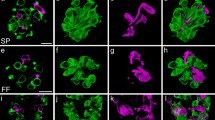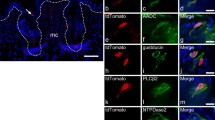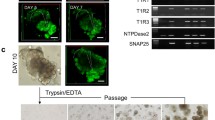Abstract
We analyzed the differentiation of taste bud cells, by precisely describing expression profiles of cytokeratins (CKs) 8 and 14 in relation to those of marker molecules including label of 5-bromo-2′-deoxy uridine (BrdU) injected. In rat circumvallate papillae, cell division was observed at the basal layer of the epithelium expressing CK14 and located outside taste buds. The progenitor cells began to migrate toward the apical surface and maintained CK14 expression at 1 day after BrdU injection (day 1). On the other hand, a minor population of newly divided cells was infrequently incorporated into taste buds and also maintained CK14 expression at day 1. In taste buds, the conversion of CK subtypes occurred from CK14 to cytokeratin 8 (CK8) at day 2–3, showing the differentiation from immature cells expressing CK14 into mature or maturing cells expressing CK8. Functionally matured cells such as taste receptor cells expressing inositol triphospate receptor type 3 (IP3R3) never expressed CK14, suggesting that CK14 would be expressed only in immature cells. On the other hand, a small but distinct population of BrdU-positive cells still showed CK14 immunoreactivity in taste buds even at day 12, which might correspond to the cells that remain undifferentiated for a long period within taste buds.



Similar content being viewed by others
References
Adler E, Hoon MA, Muekker KL et al (2000) A novel family of mammalian taste receptors. Cell 100:693–702
Asano-Miyoshi M, Abe K, Emori Y (2000) Co-expression of calcium signaling components in vertebrate taste bud cells. Neurosci Lett 283:61–64
Asano-Miyoshi M, Abe K, Emori Y (2001) IP3 receptor type 3 and PLCbeta2 are co-expressed with taste receptors T1R and T2R in rat taste bud cells. Chem Senses 26:259–265
Clapp TR, Stone LM, Margorskee RF et al (2001) Immunocytochemical evidence for co-expression of Type III IP3 receptor with signaling components of bitter taste transduction. BMC Neurosci 2:6–14
Clapp TR, Yang R, Stoick CL et al (2004) Morphologic characterization of rat taste receptor cells that express components of the phospholipase C signaling pathway. J Comp Neurol 468:311–321
Chandrasheker J, Hoon MA, Ryba NJ et al (2006) The receptors and cells for mammalian taste. Nature 444:288–294
Coulombe PA, Omary MB (2002) ‘Hard’ and ‘soft’ principles defining the structure, function and regulation of keratin intermediate filaments. Curr Opin Cell Biol 14:110–122
Hamamichi R, Asano-Miyoshi M, Emori Y (2006) Taste bud contains both short-lived and long-lived cell populations. Neuroscience 141:2129–2138
Hirota M, Ito T, Okudera K et al (2001) Expression of cyclin-dependent kinase inhibitors in taste buds of mouse and hamster. Tissue Cell 33:25–32
Huang AL, Chen X, Hoon MA et al (2006) The cells and logic for mammalian sour taste detection. Nature 442:934–938
Iwasaki S, Aoyagi H, Yoshizawa H (2003) Immunohistochemical detection of the expression of keratin 14 in the lingual epithelium of rats during the morphogenesis of filiform papillae. Arch Oral Biol 48:605–613
Knapp L, Lawton A, Oakley B et al (1995) Keratins as markers of differentiated taste cells of the rat. Differentiation 58:341–349
Purkis PE, Steel JB, Mackenzie IC et al (1990) Antibody markers of basal cells in complex epithelia. J Cell Sci 97:39–50
Stone LM, Finger TE, Tam PP et al (1995) Taste receptor cells arise from local epithelium, not neurogenic ectoderm. Proc Natl Acad Sci USA 92:1916–1920
Wang Y, Hayward WH, Cao M et al (2001) Cell differentiation lineage in the prostate. Differentiation 68:270–279
Wei-Yuan Y, Slack JMW, Tosh D (2005) Conversion of columner to stratified squamous epithelium in the developing mouse oesophagous. Dev Biol 284:157–170
Zhang C, Cotter M, Lawton A et al (1995) Keratin 18 is associated with a subset of older taste cells in the rat. Differentiation 59:155–162
Zhang C, Oakley B (1996) The distribution and origin of Keratin 20-containing taste buds in rat and human. Differentiation 61:121–127
Zhang Y, Hoon MA, Chandrasheker J et al (2003) Coding of sweet, bitter, and umami tastes: different receptor cells sharing similar signaling pathways. Cell 112:293–301
Acknowledgments
We thank M. Park for critically reading this manuscript. This work was supported in part by a grant in-aid for scientific research from the Ministry of Education, Culture, Sports, Science, and Technology of Japan.
Author information
Authors and Affiliations
Corresponding author
Rights and permissions
About this article
Cite this article
Asano-Miyoshi, M., Hamamichi, R. & Emori, Y. Cytokeratin 14 is expressed in immature cells in rat taste buds. J Mol Hist 39, 193–199 (2008). https://doi.org/10.1007/s10735-007-9151-0
Received:
Accepted:
Published:
Issue Date:
DOI: https://doi.org/10.1007/s10735-007-9151-0




